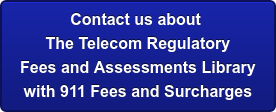 How much should you be collecting from your users for 911? Who do you send the collected fees too? How often? And can you withhold any of the collected fees to help recover your administrative costs?
How much should you be collecting from your users for 911? Who do you send the collected fees too? How often? And can you withhold any of the collected fees to help recover your administrative costs?
For a little more than half of the states, this is easy. For the remaining states, it gets messy – Brexit - Walking Dead - Windows Vista - kind of messy.
For most states, wireless or prepaid wireless communication service providers will find their 911 fees are a set amount established at the state level usually clearly set forth in the state’s statutes. For those states where the fees are set on the local level (county or city), the fees tend to remain the same amount with only the remittance locations varying.
For local wireline providers (and often this includes VoIP providers), 911 fees can be more confusing than trying to keep up with the characters on Game of Thrones.
 For many states, it’s relatively easy. They have an established wireline 911 fee amount. However, for approximately 20 states, the 911 fees and surcharges are established at the local level. If you’re a communications service provider offering service in states such as Louisiana, Kentucky, or Colorado, the 911 surcharge amounts vary significantly. In addition, several states have multiple 911 related funds with different fee amounts that work together to fund different aspects of 911 (e.g., Idaho, Michigan, Mississippi, Texas, Utah, Washington, and Wisconsin.)
For many states, it’s relatively easy. They have an established wireline 911 fee amount. However, for approximately 20 states, the 911 fees and surcharges are established at the local level. If you’re a communications service provider offering service in states such as Louisiana, Kentucky, or Colorado, the 911 surcharge amounts vary significantly. In addition, several states have multiple 911 related funds with different fee amounts that work together to fund different aspects of 911 (e.g., Idaho, Michigan, Mississippi, Texas, Utah, Washington, and Wisconsin.)
It’s these states that can cause compliance problems. 911 rates not only differ from county to county, but also by line type (residential or business). Finding these rates is quite labor intensive. Even if you’re lucky enough to find the county resolution or local ordinance, the rates aren’t there. It’s these states that make sound men and women go mad.
For example, many local ordinances state things like the rate "shall be no lower than $0.79."
Wonder how much the current fee is? We did too. And many times those we contacted didn’t know either.
OR
“The South Central Bell telephone company is hereby authorized to collect the E911 Service Charge”
South Central Bell? They haven’t gone by that name since 1992. What about all of the competitive local exchange providers, wireless providers and VoIP providers?
OR
“[The 911 fee] may be increased from time to time automatically, and the increase will be based on the Consumer Price Index”
So if it was $0.45 in 1988 surely the price has increased? We called. It hasn’t.
OR
“3% of the LEC Line rate”
Does the local jurisdiction realize the LEC line rates have changed 5-10 times since this ordinance was passed? Are they collecting the correct amounts? Do they even know what that amount is? Nope.
For those communications pro viders who want to comply, and meet their 911 funding obligations, it is an arduous process. Even the local municipalities are frustrated as they don’t have the man power or the processes to identify the carriers in their jurisdictions and ensure their compliance.
viders who want to comply, and meet their 911 funding obligations, it is an arduous process. Even the local municipalities are frustrated as they don’t have the man power or the processes to identify the carriers in their jurisdictions and ensure their compliance.
Some providers and local governments have found it so frustrating that in-house researchers have wanted to bang their heads on their desks so hard that they actually needed to call 911. Maybe you have felt that way too? That frustration was keenly felt by us as well. Companies like TMI and TTR have spent hundreds of man hours researching, assembling, monitoring, and maintaining a database of 911 fees across the country. Our staff has made countless phone calls, logged the emails, and verified these fees until we see 911 funding obligations in our sleep. We think it has been worth the stress so that providers of telecom services have a reliable resource for this data.
We know the result of our efforts is a dependable tool for providers and various agencies, making it easy to locate and understand the rates and requirements that apply to 911 fees and surcharges.
That makes us feel pretty good.




